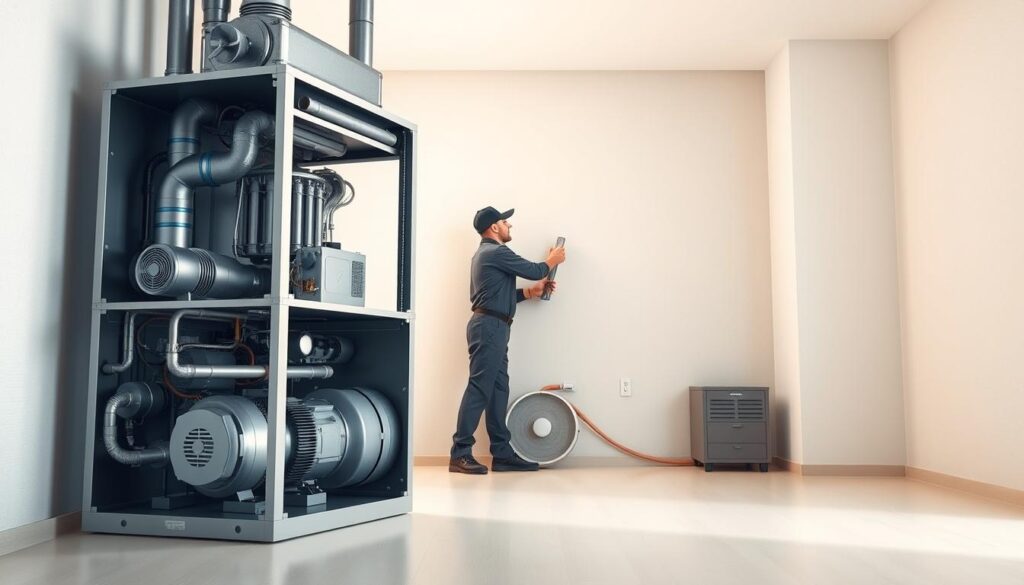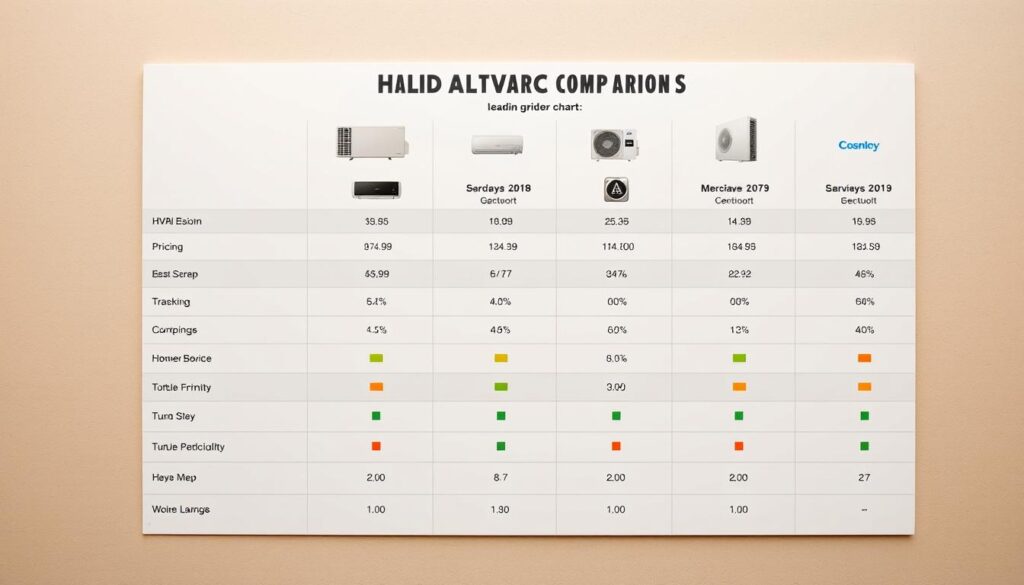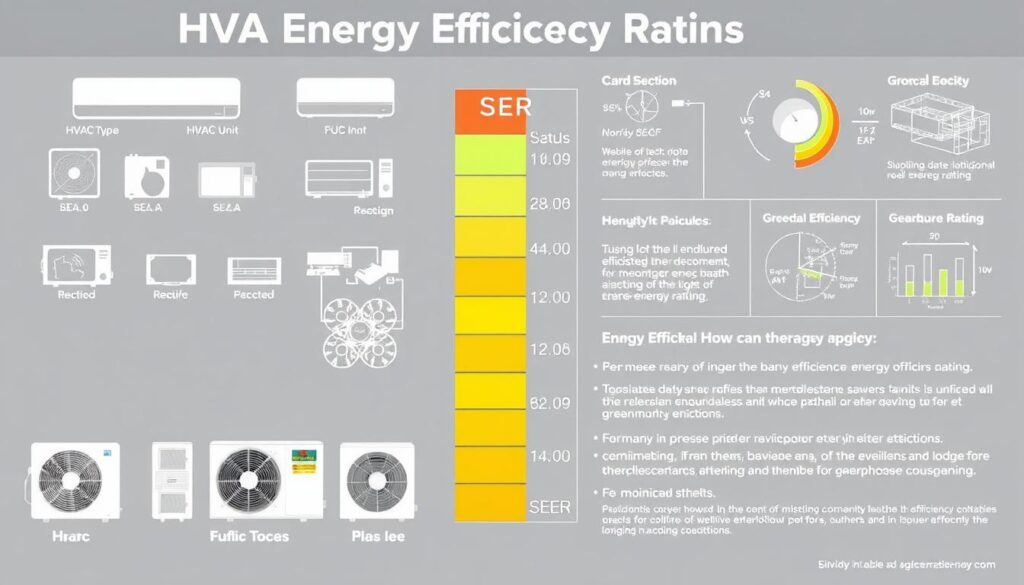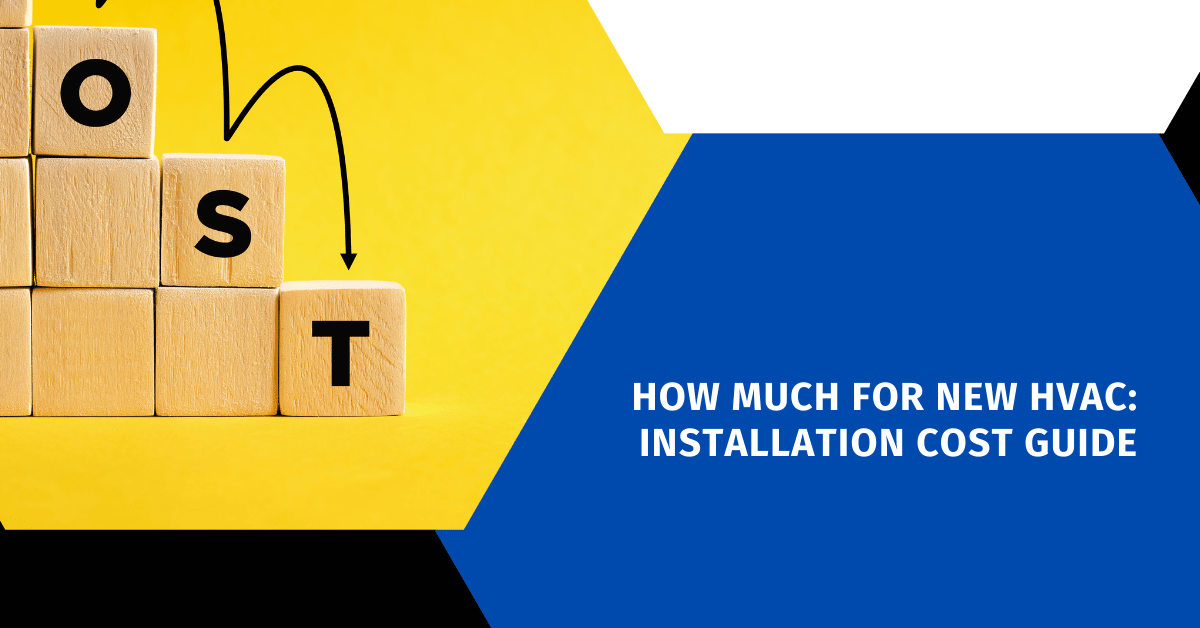Affiliate Disclosure
HVAC Guide Guys is a participant in the Amazon Services LLC Associates Program, an affiliate advertising program designed to provide a means for sites to earn advertising fees by advertising and linking to Amazon.
How Much For New HVAC? The price for a new HVAC system can vary a lot. It usually costs between $5,000 and $11,000 for a basic setup. If you need ductwork, the total cost could go up to $16,000. These prices change based on your home’s size, the system’s complexity, and where you live.

Are you curious about the cost of a new HVAC system? Knowing the cost of replacing your HVAC can help you plan your budget. It’s a key investment for your home.
The exact cost of a new HVAC system depends on a few important things. These include your home’s size, local labor costs, how efficient the equipment is, and the type of system you pick. Homeowners should get a detailed evaluation to understand the costs better than just comparing prices.
Key Takeaways
- HVAC replacement costs range from $5,000 to $16,000
- Total price depends on home size and system complexity
- Professional assessment is key for accurate pricing
- Energy efficiency affects long-term costs
- Regional prices can change a lot
Table of Contents
Understanding HVAC System Basics
When you think about getting a new HVAC system, knowing the basics is key. HVAC systems keep your home at a comfy temperature and air quality. They are complex but essential for your home’s comfort.
Modern HVAC systems have many parts that work together. The cost of a new system depends on these parts and their roles.
Central Air and Furnace Components
Your HVAC system has important parts:
- Outdoor condensing unit
- Indoor air handler
- Ductwork network
- Thermostat control system
- Refrigerant lines
Types of HVAC Systems Available
There are many HVAC systems to choose from:
| System Type | Best For | Typical Cost Range |
|---|---|---|
| Split System | Most residential homes | $3,500 – $7,500 |
| Packaged System | Smaller homes or tight spaces | $2,500 – $5,500 |
| Ductless mini-split | Supplemental heating/cooling | $2,000 – $4,500 |
Standard Installation Process Overview
The installation process for a new HVAC system includes:
- Home assessment and system sizing
- Equipment selection
- Removal of old system
- New system installation
- Ductwork modification
- Final testing and calibration
Choosing the right HVAC system is important for your home’s comfort and energy use.
Explore Our HVAC Shop
Looking for top-rated HVAC tools, parts, and accessories? Visit our shop and find the perfect solution for your needs.
Visit the ShopHow Much For New HVAC: Complete Cost Breakdown
When you’re looking to upgrade your HVAC system, knowing the total cost is key. A typical HVAC installation costs between $10,000 and $15,000 for a standard-sized home. Your exact costs will depend on several important factors.
To understand affordable HVAC replacement options, you need to look at a few key areas:
- Equipment quality and efficiency ratings
- Home square footage
- Existing ductwork condition
- Geographic location
- Brand selection
Different system types greatly affect your costs. Central air conditioning units with high-efficiency furnaces are the most common for homes. Prices vary based on:
- Basic system: $6,000 – $12,000
- Mid-range system: $12,000 – $17,000
- Premium system: $17,000 – $25,000
Remember to budget for extra costs like electrical upgrades, permit fees, and possible structural changes. Talking to licensed HVAC pros can give you a detailed estimate for your home.
HVAC Installation Costs By Home Size
Knowing how your home’s size affects the cost of a new central air conditioning system is important. The size of your home influences the complexity and cost of installing a furnace.
Different homes need different heating and cooling solutions. Contractors use special calculations to find the right system for your home.
Square Footage Cost Guidelines
The size of your home affects the cost of the HVAC system. Here are some typical costs:
- 1,000-1,500 sq ft homes: $3,000-$4,500
- 1,500-2,500 sq ft homes: $4,500-$6,500
- 2,500-3,500 sq ft homes: $6,500-$8,500
BTU Requirements Per Square Foot
Finding the right BTU (British Thermal Unit) capacity is key for efficient heating and cooling. Here’s what you usually need:
| Home Size | BTU Range |
|---|---|
| 1,000 sq ft | 18,000-21,000 BTUs |
| 1,500 sq ft | 27,000-30,000 BTUs |
| 2,500 sq ft | 45,000-50,000 BTUs |
Sizing Considerations for Different Home Types
Not all homes are the same. Things like insulation, ceiling height, and window placement affect your HVAC system’s size. Getting a professional assessment is important to find the right fit for your home.
- Single-story homes: More uniform heating/cooling needs
- Multi-level homes: Require zoned systems
- Older homes: May need additional insulation
Always talk to a professional HVAC technician for an accurate estimate. They can help you understand the cost of a new central air conditioning system and furnace installation for your home.
Explore Our HVAC Shop
Looking for top-rated HVAC tools, parts, and accessories? Visit our shop and find the perfect solution for your needs.
Visit the ShopBrand Comparison and Pricing

When looking at your hvac unit pricing guide, it’s key to know the differences between top HVAC brands. Each brand has unique features that affect your complete hvac system pricing.
Premium brands like Lennox, Carrier, and Trane are at the high-end. They offer top-notch quality and the latest tech. Their systems also come with longer warranties and better energy efficiency.
- Lennox: Known for exceptional energy efficiency
- Carrier: Industry leader with reliable performance
- Trane: Robust construction and advanced engineering
Mid-range brands like Rheem and Goodman are more affordable without losing too much quality. They provide good performance at lower prices.
| Brand | Average Cost Range | Efficiency Rating |
|---|---|---|
| Lennox | $5,000 – $8,500 | Up to 26 SEER |
| Carrier | $4,500 – $7,500 | Up to 21 SEER |
| Trane | $4,800 – $8,000 | Up to 22 SEER |
| Rheem | $3,500 – $6,000 | Up to 20 SEER |
| Goodman | $2,500 – $5,500 | Up to 18 SEER |
Your home needs and budget will decide the best HVAC system for you. Take time to research each brand’s strengths and compare their long-term value.
Ductwork Installation and Replacement Costs
When planning to install a new HVAC system, knowing the cost of ductwork is essential. The efficiency of your HVAC system greatly depends on the quality of your ductwork. Homeowners usually face two main choices: installing new ductwork or replacing the old system.
Ductwork is vital for spreading heated or cooled air across your home. When looking into the cost of a new HVAC system, remember to include ductwork expenses.
New Ductwork Installation Pricing
Several factors affect the cost of installing new ductwork:
- Home size and layout complexity
- Material selection
- Accessibility of installation areas
- Labor rates in your region
Duct Replacement Considerations
Replacing ductwork requires a detailed look. Homes or systems over 15 years old might need a full duct overhaul.
| Ductwork Type | Average Cost Range | Typical Lifespan |
|---|---|---|
| Flexible Ducts | $1.50 – $3 per linear foot | 10-15 years |
| Sheet Metal Ducts | $4 – $7 per linear foot | 20-25 years |
Material Cost Variables
The type of ductwork you choose affects the overall cost. Duct materials vary from affordable flexible options to more lasting sheet metal systems. The quality of insulation, seal, and material durability also impact performance and energy use.
Getting a professional’s opinion is important to find the best ductwork solution for your home.
Energy Efficiency and SEER Ratings Impact

When looking at the cost of replacing your HVAC, knowing about energy efficiency is key. SEER (Seasonal Energy Efficiency Ratio) ratings are important. They help figure out the cost of a new system and your energy bills over time.
Today’s HVAC systems have SEER2 ratings. These give a better idea of how well they use energy. Ratings range from 13.4 to 23.6, helping homeowners see how much they can save.
- Lower SEER ratings (13-14) are more budget-friendly initially
- Higher SEER ratings (18-23) offer substantial long-term energy savings
- Newer systems provide better overall energy efficiency
Choosing a high-efficiency HVAC system might cost more upfront. But, the long-term benefits are worth it. You’ll save on energy bills and enjoy better comfort in your home.
| SEER Rating | Initial Cost | Estimated Annual Savings |
|---|---|---|
| 13-14 | $3,000-$5,000 | $100-$200 |
| 18-20 | $5,000-$7,500 | $300-$500 |
| 21-23 | $7,500-$10,000 | $500-$700 |
When picking a new system, think about your local climate, home size, and budget. Higher efficiency doesn’t always mean the most expensive option is best for everyone. Talk to HVAC experts to find the best mix of cost and savings for you.
Additional Installation Components
When planning your new central air conditioning price, think about extra parts that can boost your home’s comfort. These extra bits can make your HVAC system work better and keep the air clean.
Thermostat Options and Costs
Today’s thermostats do more than just control the temperature. Smart thermostats help you save energy and stay comfortable:
- Basic programmable thermostats: $50-$150
- Smart WiFi-enabled thermostats: $200-$500
- Learning thermostats with advanced features: $250-$600
Zoning System Additions
Zoning systems let you control the temperature in different parts of your home. This can save a lot of energy and make your home more comfortable.
| Zoning System Type | Cost Range | Benefits |
|---|---|---|
| Basic 2-Zone System | $1,500-$2,500 | Customized temperature control |
| Advanced Multi-Zone System | $2,500-$5,000 | Comprehensive home temperature management |
Ventilation Requirements
Good ventilation is key for clean indoor air. Here are some extra parts to consider:
- Whole-house humidifier: $400-$1,200
- Whole-house dehumidifier: $1,500-$3,500
- Whole-house air purifier: $400-$4,000
Adding these extra parts can make your HVAC system more efficient and your home more comfortable. They might cost more upfront, but they can save you money and improve your living space in the long run.
Regional Cost Variations
The cost of installing a home furnace can change a lot based on where you are in the United States. Different areas face unique challenges that affect the cost of replacing HVAC systems and the overall installation price.
The climate where you live is key in determining HVAC system prices. Places with very hot summers might need stronger cooling systems. On the other hand, colder areas require more powerful heating systems. These environmental factors affect the complexity and cost of installing a furnace in your home.
- Coastal Areas: Higher humidity increases system complexity
- Desert Regions: Require specialized cooling technologies
- Mountain Zones: Need high-performance heating systems
Labor costs also play a big role in the cost of HVAC replacements across states. Cities like California and New York usually have higher installation costs than rural areas in the Midwest. This is because skilled HVAC technicians in big cities charge more, which adds to the overall cost.
Energy efficiency standards also lead to regional price differences. States with strict environmental rules, like California, require higher SEER ratings and more advanced systems. These standards can make the initial installation more expensive but can save money on energy in the long run.
Regional variations can create price differences of up to 40% for similar HVAC systems across the United States.
Knowing about these regional differences helps you plan your HVAC installation budget better. It ensures you make a choice that fits your specific location.
Explore Our HVAC Shop
Looking for top-rated HVAC tools, parts, and accessories? Visit our shop and find the perfect solution for your needs.
Visit the ShopInstallation Labor Costs
When planning a residential hvac installation price, understanding labor costs is key for homeowners. Professional HVAC installation is complex. It needs skilled technicians and special knowledge.
The hvac unit pricing guide shows labor costs range from $1,000 to $3,000. Several factors affect these costs:
- System complexity
- Home square footage
- Equipment type
- Regional labor rates
Professional vs. DIY Considerations
While DIY might seem cheap, professional installation has big benefits:
- Guaranteed workmanship
- Precise system calibration
- Compliance with local building codes
- Manufacturer warranty protection
Warranty Coverage Details
Professional installer’s warranties usually cover:
- Parts replacement
- Labor for repairs
- Performance guarantees
Certification Requirements
Reputable HVAC technicians should have:
- EPA certification
- State licensing
- Manufacturer training credentials
Investing in professional installation ensures long-term system reliability and efficiency.
Financing and Incentive Options
When you think about getting a new HVAC, knowing your financing options can help. It makes the cost of a complete HVAC system easier to handle. You don’t have to worry about it being too expensive with all the payment plans out there.
There are many ways to pay for your new HVAC system:
- Manufacturer Financing Programs
- Home Equity Loans
- Personal Loans
- Credit Card Promotions
- Energy Efficiency Financing
Government and utility incentives can also help lower your costs upfront. The Energy Star Rebate Finder and Database of State Incentives for Renewables & Efficiency (DSIRE) are great resources for finding savings.
Federal tax credits can also give you a big break for energy-efficient HVAC systems. Some key incentives include:
- Up to $500 tax credit for qualifying energy-efficient systems
- State-level rebates varying by location
- Utility company incentive programs
Check local utility providers and government websites for specific incentives in your area. Many places have special financing options that can greatly reduce your costs.
Pro Tip: Always compare multiple financing options and read the fine print before committing to any payment plan.
Conclusion
Getting a new HVAC system is a big step in improving your home. It needs careful planning and a good budget. The cost can change a lot, but knowing what affects it helps you decide.
Think about more than just the first cost. Systems with higher SEER ratings might cost more at first. But, they can save a lot on energy over time. A pro contractor can guide you, giving estimates based on your home’s needs.
Most HVAC systems last 15 to 25 years with regular care. Look into brands, know the installation costs, and focus on saving energy. This way, you invest wisely in comfort and lower energy bills. Always get several quotes and compare them before choosing.
Doing your homework and comparing options will improve your home’s comfort and energy use. Take your time to understand the details, ask questions, and pick the best value for your home.

